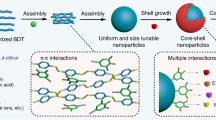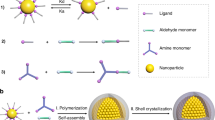Abstract
The ability of Janus nanoparticles to establish biological logic systems has been widely exploited, yet conventional non/uni-porous Janus nanoparticles are unable to fully mimic biological communications. Here we demonstrate an emulsion-oriented assembly approach for the fabrication of highly uniform Janus double-spherical MSN&mPDA (MSN, mesoporous silica nanoparticle; mPDA, mesoporous polydopamine) nanoparticles. The delicate Janus nanoparticle possesses a spherical MSN with a diameter of ~150 nm and an mPDA hemisphere with a diameter of ~120 nm. In addition, the mesopore size in the MSN compartment is tunable from ~3 to ~25 nm, while those in the mPDA compartments range from ~5 to ~50 nm. Due to the different chemical properties and mesopore sizes in the two compartments, we achieve selective loading of guests in different compartments, and successfully establish single-particle-level biological logic gates. The dual-mesoporous structure enables consecutive valve-opening and matter-releasing reactions within one single nanoparticle, facilitating the design of single-particle-level logic systems.

This is a preview of subscription content, access via your institution
Access options
Access Nature and 54 other Nature Portfolio journals
Get Nature+, our best-value online-access subscription
$29.99 / 30 days
cancel any time
Subscribe to this journal
Receive 12 print issues and online access
$259.00 per year
only $21.58 per issue
Buy this article
- Purchase on Springer Link
- Instant access to full article PDF
Prices may be subject to local taxes which are calculated during checkout






Similar content being viewed by others
Data availability
Data supporting the findings of this study are available within the Article and the associated Supplementary Information. Source data are provided with this paper.
References
Ryoo, R. Birth of a class of nanomaterial. Nature 575, 40–41 (2019).
Joo, S. et al. Thermally stable Pt/mesoporous silica core–shell nanocatalysts for high-temperature reactions. Nat. Mater. 8, 126–131 (2009).
Parlett, C. M. et al. Spatially orthogonal chemical functionalization of a hierarchical pore network for catalytic cascade reactions. Nat. Mater. 15, 178–182 (2016).
Li, W., Liu, J. & Zhao, D. Y. Mesoporous materials for energy conversion and storage devices. Nat. Rev. Mater. 1, 16023 (2016).
Lan, K. et al. Precisely designed mesoscopic titania for high-volumetric-density pseudocapacitance. J. Am. Chem. Soc. 143, 14097–14105 (2021).
Zu, L. et al. Mesoporous materials for electrochemical energy storage and conversion. Adv. Energy Mater. 10, 2002152 (2021).
Wang, C. et al. Molecular design strategy for ordered mesoporous stoichiometric metal oxide. Angew. Chem. Int. Ed. 58, 15863–15868 (2019).
Li, Z., Barnes, J., Bosoy, A., Stoddart, J. & Zink, J. Mesoporous silica nanoparticles in biomedical applications. Chem. Soc. Rev. 41, 2590–2605 (2012).
Chen, W., Glackin, C. A., Horwitz, M. A. & Zink, J. Nanomachines and other caps on mesoporous silica nanoparticles for drug delivery. Acc. Chem. Res. 52, 1531–1542 (2019).
Chen, Y. & Shi, J. Chemistry of mesoporous organosilica in nanotechnology: molecularly organic-inorganic hybridization into frameworks. Adv. Mater. 28, 3235–3272 (2016).
Liu, J., Liu, T., Pan, J., Liu, S. & Lu, G. Advances in multicompartment mesoporous silica micro/nanoparticles for theranostic applications. Annu. Rev. Chem. Biomol. 9, 389–411 (2018).
Nguyen, T. L., Choi, Y. & Kim, J. Mesoporous silica as a versatile platform for cancer immunotherapy. Adv. Mater. 31, e1803953 (2019).
Qiu, P., Ma, B., Hung, C. T., Li, W. & Zhao, D. Y. Spherical mesoporous materials from single to multilevel architectures. Acc. Chem. Res. 52, 2928–2938 (2019).
Zhao, T. C., Elzatahry, A., Li, X. M. & Zhao, D. Y. Single-micelle-directed synthesis of mesoporous materials. Nat. Rev. Mater. 4, 775–791 (2019).
Li, W., Yue, Q., Deng, Y. & Zhao, D. Ordered mesoporous materials based on interfacial assembly and engineering. Adv. Mater. 25, 5129–5152 (2013).
Zhao, T. C. et al. Interfacial assembly directed unique mesoporous architectures: from symmetric to asymmetric. Acc. Mater. Res. 1, 100–114 (2020).
Chen, C., Xie, L. & Wang, Y. Recent advances in the synthesis and applications of anisotropic carbon and silica-based nanoparticles. Nano Res. 12, 1267–1278 (2019).
Wu, Z. et al. Janus nanoarchitectures: from structural design to catalytic applications. Nano Today 22, 62–82 (2018).
Zhao, T. C. et al. Surface confined winding assembly of mesoporous nanorods. J. Am. Chem. Soc. 142, 20359–20367 (2020).
Li, X. et al. Anisotropic growth-induced synthesis of dual-compartment Janus mesoporous silica nanoparticles for bimodal triggered drugs delivery. J. Am. Chem. Soc. 136, 15086–15092 (2014).
Zhao, T. et al. Surface-kinetics mediated mesoporous multipods for enhanced bacterial adhesion and inhibition. Nat. Commun. 10, 4387 (2019).
Wang, W. et al. Engine-trailer-structured nanotrucks for efficient nano-bio interactions and bioimaging-guided drug delivery. Chem 6, 1097–1112 (2020).
Li, X. et al. Degradation-restructuring induced anisotropic epitaxial growth for fabrication of asymmetric diblock and triblock mesoporous nanocomposites. Adv. Mater. 29, 1701652 (2017).
Yang, T. et al. Dumbbell-shaped bi-component mesoporous Janus solid nanoparticles for biphasic interface catalysis. Angew. Chem. Int. Ed. 56, 8459–8463 (2017).
Zhao, T. et al. Spatial isolation of carbon and silica in a single Janus mesoporous nanoparticle with tunable amphiphilicity. J. Am. Chem. Soc. 140, 10009–10015 (2018).
Zhang, P. H. et al. A programmable polymer library that enables the construction of stimuli-responsive nanocarriers containing logic gates. Nat. Chem. 12, 381–390 (2020).
Lucks, J. B., Qi, L., Mutalik, V. K., Wang, D. & Arkin, A. P. Versatile RNA-sensing transcriptional regulators for engineering genetic networks. Proc. Natl Acad. Sci. USA 108, 8617–8622 (2011).
Seelig, G., Soloveichik, D., Zhang, D. Y. & Winfree, E. Enzyme-free nucleic acid logic circuits. Science 314, 1585–1588 (2006).
Win, M. N. & Smolke, C. D. Higher-order cellular information processing with synthetic RNA devices. Science 322, 456–460 (2008).
Strack, G., Ornatska, M., Pita, M. & Katz, E. Biocomputing security system: concatenated enzyme-based logic gates operating as a biomolecular keypad lock. J. Am. Chem. Soc. 130, 4234–4235 (2008).
Ikeda, M. et al. Installing logic-gate responses to a variety of biological substances in supramolecular hydrogel–enzyme hybrids. Nat. Chem. 6, 511–518 (2014).
Wen, J. et al. Diverse gatekeepers for mesoporous silica nanoparticle based drug delivery systems. Chem. Soc. Rev. 46, 6024–6045 (2017).
Park, J. S. et al. Disparate downstream reactions mediated by an ionically controlled supramolecular tristate switch. J. Am. Chem. Soc. 140, 7598–7604 (2018).
Karimi, M. et al. Smart nanostructures for cargo delivery: uncaging and activating by light. J. Am. Chem. Soc. 139, 4584–4610 (2017).
Seo, J. et al. Nano-bio-computing lipid nanotablet. Sci. Adv. 5, eaau2124 (2019).
Lius, B. et al. Engineering chemical communication between micro/nanosystems. Chem. Soc. Rev. 16, 8829–8856 (2021).
Diez, P. et al. Toward the design of smart delivery systems controlled by integrated enzyme-based biocomputing ensembles. J. Am. Chem. Soc. 136, 9116–9123 (2014).
Llopis-Lorente, A. et al. Interactive models of communication at the nanoscale using nanoparticles that talk to one another. Nat. Commun. 8, 15511 (2017).
Lius, B. et al. An interactive model of communication between abiotic nanodevices and microorganisms. Angew. Chem. Int. Ed. 58, 14986–14990 (2019).
Llopis-Lorente, A. et al. Stimulus-responsive nanomotors based on gated enzyme-powered Janus Au–mesoporous silica nanoparticles for enhanced cargo delivery. Chem. Commun. 55, 13164–13167 (2019).
Shen, D. et al. Biphase stratification approach to three-dimensional dendritic biodegradable mesoporous silica nanospheres. Nano Lett. 14, 923–932 (2014).
Niu, D., Ma, Z., Li, Y. & Shi, J. Synthesis of core–shell structured dual-mesoporous silica spheres with tunable pore size and controllable shell thickness. J. Am. Chem. Soc. 132, 15144–15147 (2010).
Wei, J., Yue, Q., Sun, Z., Deng, Y. & Zhao, D. Synthesis of dual-mesoporous silica using non-ionic diblock copolymer and cationic surfactant as co-templates. Angew. Chem. Int. Ed. 51, 6149–6153 (2012).
Guan, B. Y., Zhang, S. L. & Lou, X. Realization of walnut-shaped particles with macro-/mesoporous open channels through pore architecture manipulation and their use in electrocatalytic oxygen reduction. Angew. Chem. Int. Ed. 57, 6176–6180 (2018).
Chen, G. et al. General formation of macro-/mesoporous nanoshells from interfacial assembly of irregular mesostructured nanounits. Angew. Chem. Int. Ed. 59, 19663–19668 (2020).
Peng, L. et al. Versatile nanoemulsion assembly approach to synthesize functional mesoporous carbon nanospheres with tunable pore sizes and architectures. J. Am. Chem. Soc. 141, 7073–7080 (2019).
Vallet-Regi, M., Rámila, A., del Real, R. P. & Pérez-Pariente, J. A new property of MCM-41: drug delivery system. Chem. Mater. 13, 308–311 (2001).
Liu, Q., Yu, B., Ye, W. & Zhou, F. Highly selective uptake and release of charged molecules by pH-responsive polydopamine microcapsules. Macromol. Biosci. 11, 1227–1234 (2011).
Yu, B., Liu, J., Liu, S. & Zhou, F. Pdop layer exhibiting zwitterionicity: a simple electrochemical interface for governing ion permeability. Chem. Commun. 46, 5900–5902 (2010).
Huo, M., Wang, L., Chen, Y. & Shi, J. Tumor-selective catalytic nanomedicine by nanocatalyst delivery. Nat. Commun. 8, 357 (2017).
Du, L., Liao, S., Khatib, H. A., Stoddart, J. F. & Zink, J. I. Controlled-access hollow mechanized silica nanocontainers. J. Am. Chem. Soc. 131, 15136–15142 (2009).
Coll, C., Bernardos, A., Martinez-Manez, R. & Sancenon, F. Gated silica mesoporous supports for controlled release and signaling applications. Acc. Chem. Res. 46, 339–349 (2013).
Acknowledgements
We sincerely thank J. Ning and Z. He for their help with sample observations. The work was supported by the National Key R&D Program of China (2018YFA0209401, D.Z.), the National Natural Science Foundation of China (22075049, X.L.; 21875043, X.L.; 22088101, D.Z.; 21701027, X.L.; 21733003, D.Z.; 51961145403, X.L.), the Key Basic Research Program of Science and Technology Commission of Shanghai Municipality (22JC1410200, D.Z.), the Natural Science Foundation of Shanghai (22ZR1478900, X.L.; 18ZR1404600, X.L.), the Shanghai Pilot Program for Basic Research-Fudan University (22TQ004, X.L.), the Fundamental Research Funds for the Central Universities (20720220010, X.L.), the Shanghai Rising-Star Program (20QA1401200, X.L.; 22YF1402200, T.Z.) and NPRP grant NPRP12S-0309-190268 from the Qatar National Research Fund (X.L. and A.E.). The funders had no role in study design, data collection and analysis, decision to publish or preparation of the manuscript.
Author information
Authors and Affiliations
Contributions
D.Z., X.L. and T.Z. contributed to the conception and design of the experiments, analysis of the data and writing of the manuscript. L.C., M.L., R.L., W.C., C.H., S.W., L.D., A.E., F.Z. and X.L. assisted T.Z. in the synthesis of materials and data collection and analysis. All authors contributed to discussions and manuscript preparation.
Corresponding authors
Ethics declarations
Competing interests
The authors declare no competing interests.
Peer review
Peer review information
Nature Chemistry thanks Jian Liu, Ramon Martínez-Máñez and Hengquan Yang for their contribution to the peer review of this work.
Additional information
Publisher’s note Springer Nature remains neutral with regard to jurisdictional claims in published maps and institutional affiliations.
Supplementary information
Supplementary Information
Supplementary methods, figs. 1–44 and references 1–7.
Source data
Source Data Fig. 2f
Statistical source data for Fig. 2f.
Source Data Fig. 6
Statistical source data for Fig. 6.
Rights and permissions
Springer Nature or its licensor (e.g. a society or other partner) holds exclusive rights to this article under a publishing agreement with the author(s) or other rightsholder(s); author self-archiving of the accepted manuscript version of this article is solely governed by the terms of such publishing agreement and applicable law.
About this article
Cite this article
Zhao, T., Chen, L., Liu, M. et al. Emulsion-oriented assembly for Janus double-spherical mesoporous nanoparticles as biological logic gates. Nat. Chem. 15, 832–840 (2023). https://doi.org/10.1038/s41557-023-01183-4
Received:
Accepted:
Published:
Issue Date:
DOI: https://doi.org/10.1038/s41557-023-01183-4
This article is cited by
-
A Janus carbaporphyrin pseudo-dimer
Nature Communications (2024)
-
Engineering colloidal semiconductor nanocrystals for quantum information processing
Nature Nanotechnology (2024)
-
Mesoporous polymers: soft-template self-assembly synthesis and applications
Science China Chemistry (2024)
-
Janus mesoporous nanoparticles enable building biological logic systems
Science China Chemistry (2024)



